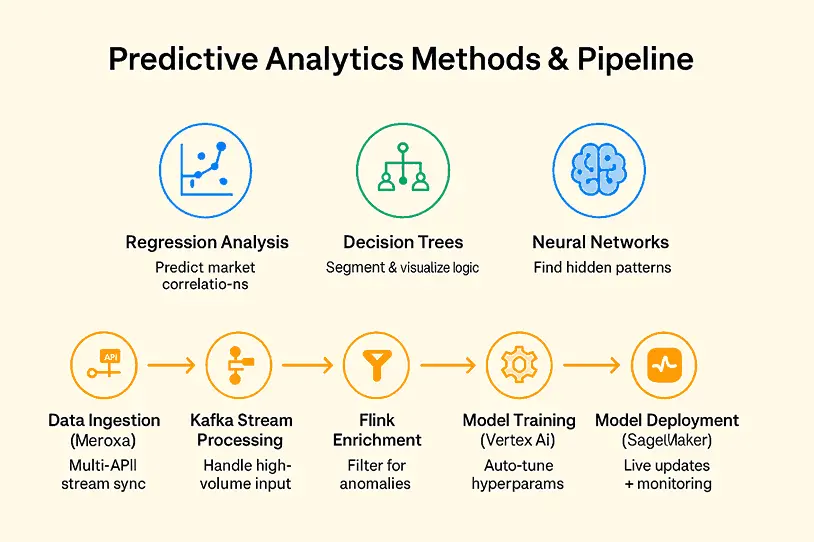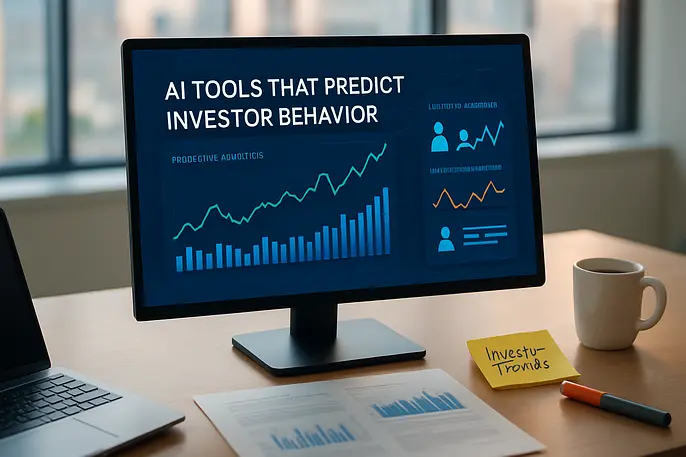With the rise of artificial intelligence, predicting investor behavior has become more precise and actionable than ever. AI tools now integrate historical trends and real-time data to uncover patterns that were once hidden, offering unparalleled insights into decision-making processes.
Recent projections show momentum building globally. By 2025, AI in finance market will reach $17 billion, growing at 25.9% annually. This rapid expansion demonstrates investor confidence in predictive technologies. Readers can expect actionable strategies shaped by this accelerating landscape.
This article delves into five cutting-edge AI tools that are transforming how businesses anticipate investor actions, helping them stay ahead in a competitive market. Let’s jump right in!
Predictive Analytics and AI Tools in Investment Management
AI tools predict investor behavior by analyzing historical and real-time data. They look for patterns in engagement, timing, and preferences, then estimate what is most likely next. The output is not certainty, it is a probability score you can use to prioritize outreach.
Predictive analytics is scaling fast across finance workflows. Grand View Research reports the market was valued at USD 18.89 billion in 2024 and could reach USD 82.35 billion by 2030. That implies a 28.3% CAGR, meaning the market grows about 28% per year on average.
Investment signals the same direction. In 2024, U.S. private AI investment hit $109.1 billion, with global forecasts approaching $200 billion by 2025. For founders, this means these tools are becoming a normal part of fundraising ops, helping you decide who to contact first, what message to send, and when to follow up.
For investors, predictive analytics offers a competitive edge by integrating diverse data sources to refine strategies. Whether analyzing historical trends or assessing current market sentiment, these tools provide actionable insights that drive informed decisions. Your exploration of predictive methods for investor behavior finds context in the broader review of AI tools for fundraising, which frames the technological landscape supporting startup strategies.
The Role of Data Governance in Predictive Analytics
Building on the integration of diverse data sources, rigorous data governance is essential for predictive analytics in investment management. Effective governance frameworks ensure data quality, security, and regulatory compliance, which underpin model reliability. Without these controls, predictive insights may be compromised by errors or breaches. Establishing robust governance practices enables investors to trust analytics outcomes and meet industry standards.
Predictive analytics is transforming investment management by offering a data-driven approach to forecasting market trends and identifying lucrative opportunities. By analyzing historical market data, economic indicators, and real-time sentiment analysis, investors can anticipate future movements with greater precision.
Predictive Analytics Methodologies and Pipeline
Recent research validates the value of these methodologies. In 2025, predictive models improved forecasting accuracy from approximately 80% to 90%. This higher precision ensures better data-driven investment decisions.
Predictive analytics combines statistical techniques and machine learning (ML) to forecast future outcomes based on historical data. Employing methodologies such as regression analysis, decision trees, and neural networks, businesses can uncover patterns that drive informed decision-making. Here's a breakdown on some of these strategies:

Iterative Model Refinement and Feedback Loops
This stage extends beyond initial model training by incorporating iterative refinement and feedback loops. Continuous monitoring of model performance allows for timely adjustments based on new data and market shifts. Regular updates and retraining help maintain accuracy and relevance, ensuring predictive analytics adapt to evolving investment conditions.
Top 5 AI Tools That Predict Investor Behavior
These AI tools that predict investor behavior help founders anticipate which investors are likely to engage, when, and on what terms.
1.PitchBook
PitchBook’s AI models digest decades of deal history to flag VCs whose pace, sector focus, and follow-on behaviour match your round; founders can run a query such as “Series A digital-health investors active in the last 90 days” and receive a ranked list complete with probability-of-response scores.
For example, a biotech founder used PitchBook to identify 20 active VCs fitting their sector and stage, leading to three qualified meetings.
2.Crunchbase Scout AI
Scout AI monitors new fund announcements, board changes, and syndicated deals across the Crunchbase graph, then surfaces “likely to invest next” alerts that help founders time outreach while an investor is still deploying fresh capital.
3.Affinity
By analysing millions of calendar, email, and CRM interactions, Affinity predicts which relationships are warming up or going cold, assigning each investor a dynamic engagement score so you can chase the hottest leads first.
4.Signalfire HELIOS
Signalfire’s in-house HELIOS platform trawls hiring patterns, product launches, and traffic spikes to anticipate where partner interest will shift; the firm shares this predictive engine with its portfolio, letting founders target VCs just as their theses evolve.
5.DocSend Advanced Analytics
DocSend’s machine-learning layer tracks how long each slide of your deck is viewed and compares behaviour to thousands of previous fundraises, alerting you when an investor’s engagement pattern resembles that of past term-sheet issuers, prompting an immediate follow-up.
Together, these tools replace guesswork with data-driven timing and prioritisation, giving founders a measurable edge in securing investor commitment.
- Evaluate your needs
- Shortlist tools for data compatibility
- Compare integration features
- Test on pilot data
- Review results
- Choose and deploy
Benefits of Predictive Analytics in Investments
Understanding risk is a core benefit of predictive analytics. A 2025 State Street survey showed only 55% of investors felt informed about portfolio risk, highlighting the need for advanced analytics. AI tools that predict investor behavior are transforming the investment landscape by offering actionable insights that drive smarter decisions.
1. Augmenting AI Insights with Human Expertise
Building on advanced decision-making capabilities, combining AI-driven analytics with expert human judgment leads to more robust investment outcomes. Human expertise provides context, intuition, and ethical oversight that algorithms may lack. This balanced approach helps investors avoid over-reliance on automation and ensures decisions align with strategic goals.
2. Enhanced Data Security
Predictive analytics plays a pivotal role in safeguarding sensitive financial data. By identifying anomalies and potential threats in real time, it ensures robust protection against cyber risks. For those interested in building secure systems, this related article on building secure fintech applications and compliance provides valuable insights into best practices for security and compliance in predictive analytics projects.
3. Effective Risk Mitigation
The ability to anticipate market fluctuations is a game-changer for risk management. Predictive models analyze historical data and market trends to forecast potential risks, enabling investors to act proactively. This real-time intelligence not only reduces exposure to volatile markets but also provides a competitive edge.
4. Improved Operational Efficiency
Streamlining operations is another significant advantage of predictive analytics. By automating repetitive tasks and optimizing workflows, it enhances overall efficiency. Drawing parallels with managed service KPIs, predictive analytics can monitor and improve operational metrics, as highlighted in this related article on setting managed services KPIs and monitoring performance.
5. Advanced Decision-Making
Predictive analytics empowers investors with data-driven insights, enabling them to make strategic decisions with greater confidence. By analyzing vast datasets, it uncovers patterns and opportunities that might otherwise go unnoticed. For those seeking professional assistance in implementing predictive analytics tools, consider this call-to-action to contact Svitla Systems.
Limitations of Predictive Analytics in Investments
Predictive analytics can improve speed and targeting, but it is not friction free. If you treat it like a magic box, it will eventually bite you.
- Black Box Risk And Low Explainability
Many models are hard to interpret, which makes it difficult to justify decisions to partners, LPs, or compliance teams. When you cannot explain why a model flagged or rejected a deal, trust drops and adoption stalls. - Compliance And Governance Pressure
Regulation is moving fast, and the burden lands on the firm, not the tool. In 2025, investment advisers cited compliance concerns as top challenges, including AI usage (57%), AML readiness (41%), and cybersecurity (38%). This is why teams need clear governance on what data is used, how outputs are reviewed, and who signs off. - Data Privacy And Security Exposure
Predictive tools often require sensitive data. Weak storage practices, messy access control, or unclear data sharing can trigger privacy breaches and erode client trust. If the data layer is not tight, the model layer does not matter. - Skill And Resource Gaps
These systems need data science, machine learning, and finance expertise to implement and maintain. Smaller firms can struggle here, which increases reliance on vendors and raises oversight risk. - Platform And Regulatory Constraints
Different platforms have different compliance and transparency capabilities, and rules vary by jurisdiction. You need tooling that supports explainability and auditability, not only accuracy, or you will spend more time fixing risk than gaining speed.
Application of Predictive Analytics in Investment Strategies
AI tools that predict investor behavior are revolutionizing how investment strategies are designed and executed. Recent portfolio shifts illustrate predictive analytics' practical impact. In 2024, equity mandates increased 4.1% while fixed income and other assets declined. This reflects changing investor priorities driven by analytics.
Institutional capital underscores the impact of predictive analytics. In 2023, Bessemer committed over $1 billion to AI-native startups. This large-scale deployment highlights real-world confidence in data-driven investment strategies, offering a robust example for portfolio planners. Here is how you can apply it:
1. Portfolio Management
Predictive analytics enables portfolio managers to analyze vast datasets and make informed decisions. For instance, the JPMorgan COIN Platform Implementation uses AI to analyze legal documents, saving thousands of hours in review time. This automation streamlines processes, allowing managers to focus on strategic adjustments that improve portfolio performance. Learn more.
2. Asset Allocation
Dynamic asset allocation is another area where predictive analytics excels. Tools like machine learning algorithms can forecast market trends by analyzing structured data, such as earnings calls and financial communications. Goldman Sachs ML Algorithm Implementation exemplifies this approach, enabling rapid shifts in asset allocation to capitalize on emerging opportunities. Explore the details.
3. Market Timing
Timing the market effectively requires precise predictions. Predictive analytics empowers investors to identify optimal entry and exit points by analyzing historical data and real-time market signals. This capability reduces the risk of losses and enhances returns.
4. Risk Management
Real-time fraud detection is a critical application of predictive analytics in risk management. For example, Visa’s predictive models analyze transaction patterns within milliseconds, safeguarding against fraud while maintaining operational efficiency. This proactive approach minimizes risks and ensures portfolio stability. Read more.
Portfolio Optimization & Dynamic Investment Strategy
Advanced tools like Monte Carlo simulations (computer-based models that use repeated random sampling to estimate possible outcomes) play a pivotal role in portfolio optimization. Using stochastic modeling (randomized simulations), investors assess how portfolios perform under different market conditions. Repeated randomized testing clarifies best-case, worst-case, and median outcomes, enabling dynamic adjustments to maximize returns.
Predictive analytics not only enhances investment performance but also facilitates real-time rebalancing and strategic shifts. These capabilities empower investors to mitigate losses and seize opportunities, ensuring portfolios remain agile in fluctuating markets.
AI-Driven Investment Strategies and Future Outlook
Looking ahead, several transformative trends are set to redefine AI-driven investment strategies. Explainable AI, for instance, is gaining traction as regulatory bodies and investors demand greater transparency in how machine learning models make decisions. This shift is particularly relevant in the BFSI sector, where clear accountability is critical. Blockchain technology is another game-changer, offering secure and decentralized equity tracing solutions that could enhance trust and efficiency in financial transactions. Additionally, quantum computing is poised to revolutionize predictive modeling by enabling high-fidelity simulations that tackle complex investment scenarios with unprecedented accuracy.
Projections suggest that by 2030, up to 30% of investment advisory tasks could be automated. This automation will likely extend beyond routine processes, incorporating proprietary analysis layers that combine AI insights with human expertise. As firms explore these advancements, they must also consider how to integrate next-generation solutions like startup investor matchmaking platforms to connect analytical insights with broader investment ecosystems.
How Qubit Capital Enhances Investor-Prediction Efforts
Qubit Capital layers a proprietary AI-scoring engine on top of a 20 000-plus investor graph to predict which VCs or angels are most likely to engage with a specific startup, factoring thesis fit, check size, geography, and recent deal velocity. These relevancy scores power targeted introductions and automated outreach sequences, giving founders a data-backed shortlist instead of a generic investor dump.
Because the platform continuously ingests fresh funding announcements and relationship feedback loops, its models refine probabilities in real time, helping teams time follow-ups, prioritize high-intent investors, and ultimately close rounds up to 2× faster.
Conclusion
AI tools that predict investor behavior have emerged as transformative solutions for refining investment strategies. Adopting these innovative strategies can significantly improve investment outcomes, empowering businesses to stay ahead in a competitive landscape. As technology continues to evolve, the integration of predictive analytics will remain pivotal in shaping smarter, data-driven investment decisions.
If you’re looking to uncover the right investors for your next venture, we at Qubit Capital offer AI-driven Investor Discovery and Mapping services. Get in touch to transform your investor strategy today.
Key Takeaways
- Predictive analytics utilizes both historical and real-time data to transform investment strategies.
- Incorporating diverse data sources is critical for accurately predicting investor behavior.
- Advanced machine learning techniques and robust data pipelines improve decision-making and reduce risks.
- Real-world case studies highlight the tangible advantages of AI in managing investments.
- Emerging trends like explainable AI, blockchain integration, and quantum computing are set to redefine investment advisory services.
Frequently asked Questions
Which AI tools are best for predicting investor behavior?
Top AI tools for predicting investor behavior in 2024 include PitchBook, Crunchbase Scout AI, Affinity, Signalfire HELIOS, and DocSend Advanced Analytics.






